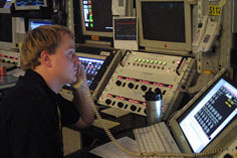
Handy Links
SLAC News Center
SLAC Today
- Subscribe
- Archives: Feb 2006-May 20, 2011
- Archives: May 23, 2011 and later
- Submit Feedback or Story Ideas
- About SLAC Today
SLAC News
Lab News
- Interactions
- Lightsources.org
- ILC NewsLine
- Int'l Science Grid This Week
- Fermilab Today
- Berkeley Lab News
- @brookhaven TODAY
- DOE Pulse
- CERN Courier
- DESY inForm
- US / LHC
SLAC Links
- Emergency
- Safety
- Policy Repository
- Site Entry Form

- Site Maps
- M & O Review
- Computing Status & Calendar
- SLAC Colloquium
- SLACspeak
- SLACspace
- SLAC Logo
- Café Menu
- Flea Market
- Web E-mail
- Marguerite Shuttle
- Discount Commuter Passes
-
Award Reporting Form
- SPIRES
- SciDoc
- Activity Groups
- Library
Stanford
Around the Bay
Looking for the "On" Button
 After a hiatus of more than four months, SLAC's linear accelerator this week resumes its job delivering beams of electrons and positrons to PEP-II. The task of cycling the linac back into action began last November, the whole process taking a team of more than 400 engineers, physicists and technicians two months to achieve. Turning SLAC's historic workhorse back on, perhaps not surprisingly, turns out to be quite a bit more complicated than simply pressing the "on" button.
After a hiatus of more than four months, SLAC's linear accelerator this week resumes its job delivering beams of electrons and positrons to PEP-II. The task of cycling the linac back into action began last November, the whole process taking a team of more than 400 engineers, physicists and technicians two months to achieve. Turning SLAC's historic workhorse back on, perhaps not surprisingly, turns out to be quite a bit more complicated than simply pressing the "on" button.
The first priority for linac operators, of course, is safety. And with more than three miles of underground tunnels that must remain off-limits when the accelerator and PEP storage rings are running, it is little wonder the meticulous process of securing the linac housing and PEP tunnels takes time. In the case of the most recent shut down, a laundry list of Linac Coherent Light Source (LCLS) preparations, PEP-II upgrades, and maintenance projects filled the four-month calendar. Completing all this work and getting the linac back up to speed on schedule has required a complex choreography of overlapping activities.
"The searches and inspections started two months ago," said Roger Erickson, head of the Accelerator Operations Department, which runs the linac. "If everything worked perfectly and nothing else were going on, this process might take as little as three weeks, but in reality you can't separate things like that. The complexity of the task requires us to start sequentially securing and then reopening certain sections as the work continues."
SLAC's tunnel complex is divided into 26 personnel protection zones. After the accelerator has been manually inspected and "cold checked" to ensure each component is in working order, each zone must be searched and secured by a team of accelerator operators and extensively tested by the Personnel Protection System Group before "hazards"—such as high voltage electricity or radiation-generating klystrons—can be turned back on. During this process, workers manually test all the safety interlock switches, door locks, banks of access keys, and a variety of radiation detectors and beam stoppers.
"It's analogous to your microwave oven," Erickson said. "You wouldn't want to be inside while it's on, but if you open the door it's perfectly safe because of the interlock system."
The complexity of the accelerator and the huge number of delicate components it relies on mean that restoring power to the linac can be a time consuming process. Some components inevitably expire during any down time. On average, Erickson said, at least some of the magnet power supplies, klystrons, and other devices do not work when operators attempt to power them back up, and they must be repaired or replaced. Bringing the electron gun—which initiates the beam—up to full operating voltage takes several days, as does restoring a good vacuum to the accelerator itself.
Ideally, systems such as the vacuum, water cooling and control systems are left running during any down time. Owing partly to the new LCLS injector installation, the shutdown of 2006 was especially invasive, and that has contributed to the complexity of turning the linac back on.
"Just because the beam's been off for a while doesn't mean we can push a button to turn it back on," said Erickson. "This time around it's been a rather choreographed procedure—something like a third of the SLAC population has helped in getting the linac back up."
óBrad Plummer, SLAC Today, January 8, 2007
Above image: Matt Cyterski of the Accelerator Operations Department tests radiation safety systems in preparation for turning on the accelerator. (Click on image for larger version.)